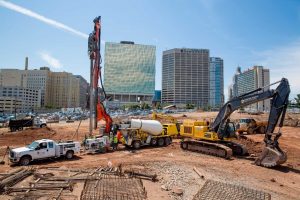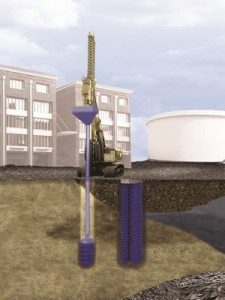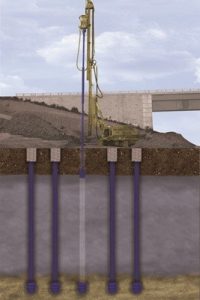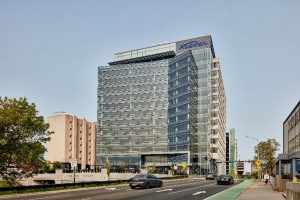

Derek Simpson
by Derek Simpson
The future of Geopier ground improvement in the Northeast is a bright one. Pushing the boundaries of our in-house engineering and technology will take us to new heights, literally and figuratively. Say goodbye to the days of only supporting lightly loaded, low-rise structures, and say hello to the present and future of supporting taller, 10+ story structures. Here’s a round-up of the top eight ground improvement myths.

Geopier GCC installation
Myth No. 1. Caving soils or shallow groundwater conditions preclude the use of ground improvement.
Geopier Impact Rammed Aggregate Pier and GeoConcrete Column (GCC) rigid inclusion systems utilize a specialty displacement mandrel that is vibrated into the ground using low-amplitude, high-frequency energy. The mandrel acts as a temporary casing, which makes these Geopier technologies a great match for sites with caving soils or shallow groundwater conditions.

Geopier Impact RAP installation
Myth No. 2. Thick layers of relatively soft soils, such as organics or clay, preclude the use of ground improvement.
In the past, the presence of soft soil layers such as organics and soft clays would generally require excavation/replacement or deep foundations such as driven piles, drilled piles, or pressure injected footings (PIFs).
Today, however, Geopier rigid inclusions such as grouted Impact RAP elements and GCCs help transfer loads through soft soil layers that are more than 20-ft. thick and allow for traditional shallow footing support without the need for pile caps and grade beams.

Geopier Grouted Impact RAP installation

Geopier GCC Rigid Inclusion installation
Myth No. 3. If relatively soft soils, such as organics or clay, are present at/near the proposed bottom-of-footing elevation, then ground improvement cannot be used.
The use of Geopier Rammed Aggregate Pier elements and rigid inclusions, such as grouted Impact RAP elements or GCCs, can provide a suitable bearing subgrade for shallow footings that are close to, and sometimes within, a relatively soft soil layer such as organics or clay.
Myth No. 4. Ground improvement is only suitable for lightly loaded, low-rise structures. For more heavily loaded, mid-rise structures, deep foundations such as driven piles, drilled piles, or PIFs are necessary to limit settlement within acceptable tolerances.
Ground improvement is widely used to support heavily loaded, mid-rise structures on shallow footings and slabs-on-grade, even on sites where thick layers of unsuitable soils are present. Thus, if you are evaluating a site and you believe that deep foundations are necessary, Geopier ground improvement may offer a more cost-effective alternative.
Helical recently used Geopier GCCs as a value-engineering alternative to augercast piles to support a 14-story office building and 10-story parking garage with loads that exceeded 4,000 kips and wall footing loads that surpassed 60 kips per linear foot.
Myth No. 5. Ground improvement can only be used effectively if the unsuitable soil layer thickness is less than 15- to 25-feet thick.
Advances in Geopier technology and equipment have allowed for ground improvement to be used effectively on sites where the unsuitable soils (such as fill and organics) extend well beyond 25 feet deep.
Myth No. 6 Ground improvement can be used effectively on sites with thick, natural compressible clay or inorganic silt layers, but only if the ground improvement elements fully penetrate through the clay or inorganic silt layers and into an underlying relatively dense/stiff soil layer.
It is standard practice in the Northeast to fully penetrate unsuitable man-placed fill and natural compressible organic layers (peat, organic silt) with Geopier ground improvement elements that extend into underlying natural soil layers. However, Geopier elements do not necessarily need to fully penetrate through thick, natural compressible clay or inorganic silt layers and into an underlying natural soil layer provided that total settlement in the Geopier-element-reinforced “upper zone” and unreinforced “lower zone” is acceptable. In effect, Geopier elements can be used to create an “engineered crust” in the upper zone of thick, natural compressible layers such as clay or inorganic silt.
Myth No. 7. Ground improvement always requires pre-augering at element locations and therefore always generates excess spoils.
With reference to Myth No. 1, Geopier Impact RAP element and GCC systems utilize a specialty displacement mandrel that is vibrated into the ground using low-amplitude, high-frequency energy. The displacement mandrel allows for a bottom-feed construction process that typically does not require pre-augering or generate excess spoils. For sites with dense to very dense fill soils, pre-augering is sometimes required to help the mandrel penetrate though the fill.

GCC Rigid Inclusions support 14-story office building and 10-story parking garage.
Myth No. 8. Ground improvement is only cost-effective on large projects due to relatively high mobilization costs.
Ground improvement can be a cost-effective alternative to excavate/replace, even on some smaller projects, particularly if special measures are required for excavate/replace to be feasible, such as excavation support, dewatering, and/or contaminated soil disposal. Relatively small projects (<5,000sf to 7,500sf footprint) can be cost-effectively supported on Geopier elements, including restaurants, banks, gas stations, and single-story retail buildings.
Check out a case study featuring the Assembly Row project in Somerville, MA to see how Helical provided a ground improvement solution on a site where heavily-loaded footings were located within a thick organic layer.
Check out a case history on the 100 College Street project in New Haven, CT to see how Helical used Geopier GCCs as a value-engineering alternative to augercast piles to support a 14-story office building and 10-story parking garage with loads that exceeded 4,000 kips and wall footing loads that surpassed 60 kips per linear foot.
Read about Helical’s recent projects here.










